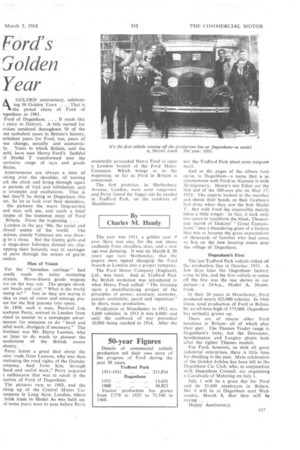Ford's olden Year
Page 75

If you've noticed an error in this article please click here to report it so we can fix it.
By Charles M. Heady
ALGOLDEN anniversary, celebrating 50 Golden Years ... . That is the proud claim of Ford of
■ agenham in 1961.
Ford of Dagenham. . . . It reads like 1 entry in Debrett. •A title earned for :rvices rendered throughout 50 of the ost turbulent years in Britain's history.
urbulent years for Ford, too, years of vat change, socially and economicly. Years in which Britain, and the orld, have seen Henry Ford's faithful Id Model T transformed into the ipressive range of cars and goods :hides.
Anniversaries are always a time of 13king over the shoulder, of turning lek the clock and living through again Le periods of trial and tribulation, and Le triumphs and exultations. That is hat they'll be doing at Dagenham this :ar. So let us look over their shoulders, : the pictures the many long-service ord men will see, and catch a brief impse of the immense story of Ford • Britain. From the beginning. . . .
London in the gay '90s, the social and iltural centre of the world. The maim's, stately Victorian era was draw ig to a close. But the Gaiety girls and Le stage-door Johnnies danced on, clip opping their leisurely way in carriages id pairs through the streets of gas-lit ondon.
Man of Vision Yet the " horseless carriage" had ready made its noisy stuttering itrance. Horse-drawn goods wagons ere on the way out. The people shook Leir heads and said: " What is the world 'ming to?" Just as they are saying it iday as men of vision and courage preIre for the first journey into space.
In 1894, such a man, Percival Lea lewhurst Perry, arrived in London from ristol in answer to a newspaper adversement for someone to do "hard and ;dui work, drudgery if necessary." The ivertiser was Mr. Harry Lawson, who as later to do much to pioneer the nindations of the British motor idustry. '
Perry learnt a great deal about the Lotor trade from Lawson, who was then :veloping the road rights of the Daimler ompany. And from him, through hard and useful work," Perry acquired 1 enthusiasm that was to result in the .eation of Ford of Dagenham.
The pictures turn to 1903, and the Ming up of the Central Motor Car ompany in Long Acre, London, where brisk trade in Model As was built up, ut some years were to pass before Perry eventually persuaded Henry Ford to open a London branch of the Ford Motor Company. Which brings us to the beginning, so far as Ford in Britain is concerned.
The first premises, in Shaftesbury Avenue, London, were soon outgrown. and Perry found the bigger site he needed in Trafford Park, on the outskirts of Manchester.
The year was 1911, a golden year if ever there was one, for the sun shone endlessly from cloudless skies, and a new age was dawning. It was on March 8, 50 years ago next Wednesday, that the papers were signed changing the Ford branch in London into a proper company.
The Ford Motor Company (England), Ltd., was born. And at Trafford Park the British workman was introduced to what Henry Ford called: "The focusing upon a manufacturing project of the principles of power, accuracy, economy, system continuity, speed and repetition." In short, mass production.
Production at Manchester in 1912 was 3,000 vehicles; in 1913 it was 6,000; and only the outbreak of war prevented 10,000 being reached in 1914. After the war the Trafford Park plant soon outgrew itself.
And so the pages of the album turn again, to Dagenham—a name that is as synonymous with Ford as Alamein is with Montgomery. Henry's son Edsel cut the first sod of the 500-acre site on May 17, 1929. The experts looked at the marshes and shook their heads, as their forebears had done when they saw the first Model T. But with Ford the impossible merely takes a little longer. In fact, it took only two years to transform the bleak, Thamesside marsh of Dickens' " Great Expectations " into a thundering giant of a factory that was to become the great expectations of thousands of families who had come to live on the new housing estate near the village of Dagenham.
Dagenham's First The last Trafford Park vehicle rolled off the production line in October, 1931. A few days later the Dagenham factory came to life, and the first vehicle to come off the line was the one shown in our picture—a 24-h.p., Model A, 30-cwt. truck.
In their 20 years at Manchester, Ford produced nearly 422,000 vehicles In 1960 alone, total production of Ford in Britain hit an all-time high of 575,000. Dagenham has certainly grown up.
There are of course other Ford locations in Britain—all of which play their part. The Thames Trader range is Dagenham's baby, but the Doncaster, Southampton and Langley plants look after the lighter Thames models.
For Ford, however, as with all great industrial enterprises, there is little time for dwelling in the past. Main celebration of the Golden Jubilee has been left to the Dagenham Car Club, who, in conjunction with Dagenham Council, are organizing a Cavaivade of Motoring on July 1.
July 1 will be a great day for Ford and its 55,000 employees in Britain.
But it will be at Dagenham next Wednesday, March 8, that they will be saying .
Happy Anniversary.




































































































































